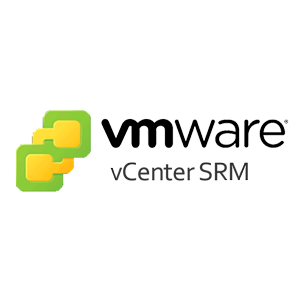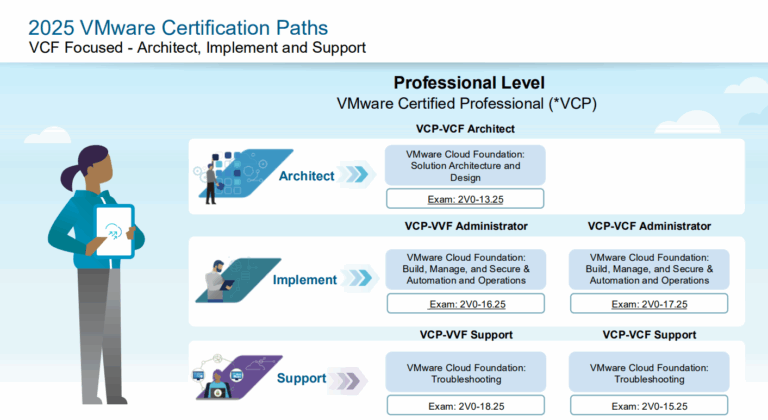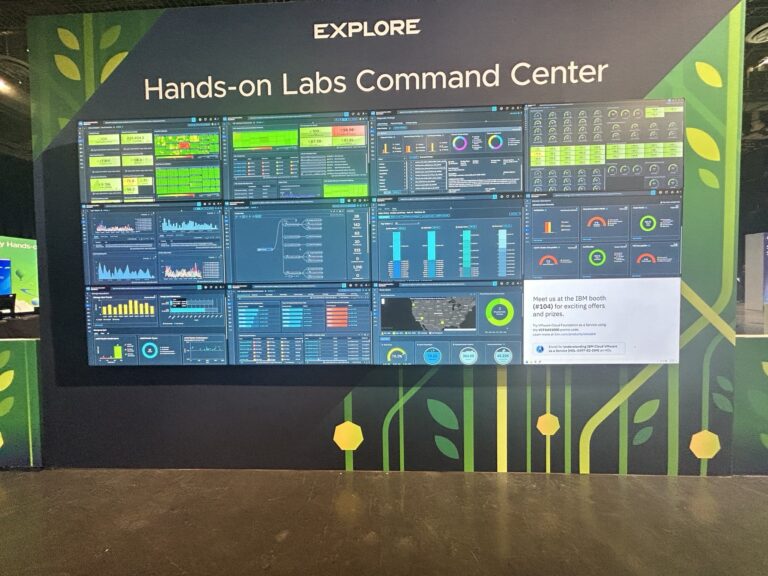VMware SRM is integral to an organization’s overall enterprise architecture, specifically within the Business Continuity and Disaster Recovery domain. It enables the implementation of a comprehensive disaster recovery strategy for virtualized environments, ensuring the availability and recoverability of critical business services in the face of disruptions.
From an architectural perspective, VMware SRM provides several key features and benefits:
- Standardization: VMware SRM supports using industry-standard protocols, interfaces, and technologies, ensuring compatibility and interoperability with various virtualization platforms, storage arrays, and networking components. This adherence to standards promotes architectural consistency and avoids vendor lock-in.
- Integration: VMware SRM integrates with existing virtualization infrastructure components such as vSphere, ESXi hosts, and vCenter Server. This integration enables the orchestration of recovery processes and automates failover and failback operations.
- Modularity: VMware SRM follows a modular architecture, allowing organizations to deploy and scale the solution according to their specific recovery requirements. The modular approach supports the creation of recovery plans tailored to different business services, enabling granular control and flexibility in the recovery process.
- Data Replication: VMware SRM leverages storage-based replication or array-based replication technologies to ensure the synchronization and replication of virtual machine data between the primary site and the secondary (recovery) site. This architectural approach provides data integrity and minimizes data loss during recovery operations.
- Testing and Validation: VMware SRM supports the testing and validating recovery plans without impacting the production environment. This capability allows architects to verify the effectiveness of the recovery strategy, evaluate the recovery time objectives (RTOs) and recovery point objectives (RPOs), and identify any architectural gaps or areas for improvement.
- Scalability and Performance: VMware SRM is designed to handle large-scale virtualized environments and can simultaneously accommodate the recovery of numerous virtual machines. This scalability ensures that the solution can meet the organization’s recovery requirements as the virtual infrastructure grows.
- Security and Compliance: VMware SRM integrates with security frameworks and practices, ensuring data transmission and storage during recovery adhere to security standards and regulatory requirements. This architectural consideration helps protect sensitive data and maintains compliance with industry regulations.
Business Continuity and Disaster Recovery
Explaining the terms “Business Continuity” and “Disaster Recovery” and their respective domains.
- Business Continuity: Business Continuity refers to an organization’s ability to continue its critical operations and deliver products or services during and after a disruptive event. It involves developing strategies, plans, and processes to ensure that essential functions are maintained or quickly resumed during a disruption. Business continuity aims to minimize disruptions’ impact on an organization’s operations, reputation, and financial stability.
The Business Continuity domain encompasses several key activities:
a. Business Impact Analysis (BIA): This involves identifying and prioritizing critical business functions and assessing the potential impact of disruptions on these functions. The BIA helps determine each critical function’s recovery time objectives (RTO) and recovery point objectives (RPO).
b. Risk Assessment and Management: This involves identifying potential risks and vulnerabilities that could lead to disruptions and implementing measures to mitigate those risks. It includes risk analysis, risk mitigation planning, and establishing preventive controls.
c. Business Continuity Planning (BCP): BCP involves developing plans and procedures to ensure the continuity of critical business functions. This includes defining roles and responsibilities, establishing alternate operating locations, implementing data backup and recovery mechanisms, and establishing communication channels during a disruption.
d. Testing and Exercising: Regular testing and exercising of the business continuity plans are essential to ensure their effectiveness. This involves conducting drills, simulations, and tabletop exercises to validate the plans, identify gaps, and improve response capabilities.
- Disaster Recovery: Disaster Recovery focuses on restoring IT infrastructure and systems following a disruptive event. It involves having processes and procedures in place to recover IT resources, such as servers, networks, databases, applications, and data, after a disaster or major incident. The primary objective of disaster recovery is to minimize downtime and restore critical IT services to an acceptable level within the defined RTO and RPO.
The Disaster Recovery domain includes the following elements:
a. Disaster Recovery Planning (DRP): DRP involves developing strategies and plans to recover IT infrastructure, systems, and data during a disaster. This includes defining recovery objectives, establishing recovery procedures, and identifying the necessary resources and technologies to support recovery.
b. Backup and Recovery: This involves implementing mechanisms to regularly back up critical data and systems to ensure their availability for recovery purposes. It includes determining backup frequencies, storage locations, and backup validation processes.
c. Replication and Redundancy: Organizations often implement replication and redundancy solutions to minimize downtime and data loss. These technologies enable the real-time or near-real-time synchronization of data and the availability of redundant hardware or infrastructure to support rapid recovery.
d. Testing and Maintenance: Similar to business continuity, regular testing and maintenance of disaster recovery plans and mechanisms are crucial. Testing ensures that the recovery procedures are effective and align with the defined RTO and RPO. Maintenance involves keeping the plans current, and incorporating changes in technology and business requirements.
In summary, while business continuity focuses on the overall ability of an organization to continue critical operations during and after disruptions, disaster recovery focuses specifically on the recovery of IT infrastructure and systems. Both domains are vital for ensuring the resilience and survival of an organization in the face of adverse events.
SRM competition
The main competitors to VMware SRM (Site Recovery Manager) in the field of disaster recovery for virtualized environments include:
- Zerto: Zerto provides a comprehensive disaster recovery and data protection solution for virtualized and cloud environments. It offers continuous data protection, near-zero recovery time objectives (RTOs), and cross-hypervisor support.
- Veeam: Veeam specializes in data protection and availability solutions for virtual, physical, and cloud-based environments. It offers a wide range of products, including Veeam Backup & Replication, which provides disaster recovery capabilities for VMware and Hyper-V environments.
- Dell EMC RecoverPoint: RecoverPoint is a data protection and replication solution offered by Dell EMC. It provides continuous data protection and replication at the block level, supporting both VMware and non-VMware environments.
High-level comparison
VMware SRM:
Pros:
- Integration with VMware Infrastructure: SRM is tightly integrated with VMware’s vSphere platform, leveraging its features and capabilities for seamless replication and failover/failback processes.
- Robust Orchestration and Automation: SRM provides advanced orchestration and automation features, allowing for the creation of detailed recovery plans and streamlined recovery workflows.
- Application Consistency: SRM focuses on maintaining application consistency during recovery, working with application-aware tools to ensure data integrity and recoverability.
- Centralized Management: SRM offers a centralized management interface, providing a holistic view of the DR environment and simplifying administration.
Cons:
- Cost: SRM can be more expensive than other alternatives, requiring VMware licenses and additional components such as vSphere Replication or third-party storage-based replication.
- Complexity: Implementing and managing SRM can be complex due to its integration with VMware infrastructure and advanced features. It may require specialized skills and expertise.
- Limited Cross-Hypervisor Support: SRM primarily focuses on VMware environments, which may not be suitable for organizations with a multi-hypervisor infrastructure.
Veeam:
Pros:
- Cross-Hypervisor Support: Veeam supports VMware and Microsoft Hyper-V environments, making it a versatile choice for organizations with a mixed virtualization infrastructure.
- Wide Range of Features: Veeam offers comprehensive data protection and availability features, including backup, replication, and recovery capabilities.
- Ease of Use: Veeam is known for its user-friendly interface and ease of implementation and management, making it accessible to organizations with limited IT resources.
- Cost-Effective: Veeam’s pricing model is often considered competitive, providing value for money regarding its features and functionality.
Cons:
- Dependency on Third-Party Hypervisors: While Veeam supports multiple hypervisors, its integration and feature set may not be as comprehensive or tightly integrated with VMware as VMware SRM.
- Application Consistency: While Veeam offers application-level recovery options, its approach to maintaining application consistency during recovery may not be as advanced as SRM’s integration with application-aware tools.
- Potential Performance Impact: Depending on the size and complexity of the environment, Veeam’s backup and replication processes may impose a performance overhead on the production infrastructure.
Zerto:
Pros:
- Hypervisor Agnostic: Zerto supports multiple hypervisors, including VMware vSphere, Microsoft Hyper-V, and AWS, offering flexibility for different virtualization platforms.
- Continuous Data Protection: Zerto provides near-real-time replication, ensuring minimal data loss during disaster recovery scenarios.
- Orchestration: Zerto offers robust orchestration capabilities, allowing for customized recovery workflows and automation of complex tasks.
- Multi-Cloud Support: Zerto enables disaster recovery across on-premises environments and public clouds, facilitating hybrid and multi-cloud strategies.
Cons:
- Additional Infrastructure: Zerto requires additional infrastructure components, such as Zerto Virtual Replication Appliances (VRAs), which may add complexity to the environment.
- Cost: Zerto can be relatively expensive compared to other disaster recovery solutions, considering both licensing and infrastructure requirements.
- Learning Curve: While Zerto offers extensive features, mastering its advanced capabilities may take time and effort.
RecoveryPoint:
Pros:
- Flexibility: RecoveryPoint supports a range of platforms and environments, including physical, virtual, and cloud-based systems, allowing for heterogeneous IT environments.
- Comprehensive Solutions: RecoveryPoint offers various disaster recovery services, including backup, replication, and cloud-based recovery, providing comprehensive data protection.
- Expertise: RecoveryPoint has extensive experience in disaster recovery and offers specialized expertise in managing and recovering data.
- Compliance Support: RecoveryPoint provides solutions that adhere to industry regulations and compliance requirements, such as HIPAA and PCI DSS.
Cons:
- Learning Curve: Implementing and managing RecoveryPoint solutions may require some learning and adjustment, especially if you’re unfamiliar with the platform.
- Cost: RecoveryPoint’s services can be relatively expensive, depending on the scale and complexity of your disaster recovery requirements.
- Vendor Lock-in: Depending on your reliance on RecoveryPoint’s infrastructure and services, there may be concerns about vendor lock-in and potential difficulties migrating to alternative solutions.
Why SRM
- Comprehensive Disaster Recovery Solution: VMware SRM provides a comprehensive disaster recovery solution for virtualized environments. It enables organizations to protect their critical applications and data by automating the failover and failback processes. This ensures minimal downtime and data loss during a disaster or system outage.
- Seamless Integration with VMware Infrastructure: VMware SRM integrates seamlessly with VMware’s virtualization infrastructure, including VMware vSphere and vCenter Server. This integration allows for efficient replication and recovery of virtual machines (VMs) and simplifies managing the entire disaster recovery process.
- Simplified Recovery Plan Creation and Testing: SRM offers a user-friendly interface for creating recovery plans, which define the sequence of actions to be taken during a disaster recovery scenario. These plans can be customized based on an enterprise’s specific needs. Additionally, SRM provides non-disruptive testing capabilities, allowing organizations to validate their recovery plans without impacting production systems.
- Automated Disaster Recovery Operations: One of the key advantages of VMware SRM is its automation capabilities. It automates the process of detecting and recovering from a disaster, reducing the reliance on manual intervention. This automation ensures consistency, accuracy, and speed in executing recovery operations, minimizing human errors, and improving recovery time objectives (RTOs).
- Centralized Management and Monitoring: SRM provides a centralized management and monitoring console, which allows administrators to monitor the health and status of replication, conduct regular tests, and troubleshoot any issues. This centralized approach simplifies the management of disaster recovery operations across multiple sites and enhances overall visibility and control.
- Flexibility and Scalability: VMware SRM supports a wide range of storage technologies and replication options, offering flexibility in choosing the most suitable solution for an enterprise’s infrastructure. It also scales well with the growth of the virtual environment, ensuring that disaster recovery capabilities can be easily expanded as the business evolves.
- Compliance and Audit Readiness: For organizations operating in regulated industries or those with strict compliance requirements, VMware SRM can help meet the necessary criteria. It provides documentation and reporting capabilities, facilitating compliance audits and ensuring disaster recovery processes align with industry standards and regulations.
- Proven Track Record and Industry Recognition: VMware is a globally recognized leader in virtualization and has a proven track record of providing reliable solutions for disaster recovery. Enterprises across various industries widely adopt VMware SRM, and its reputation and industry recognition provide confidence in its effectiveness and stability.




